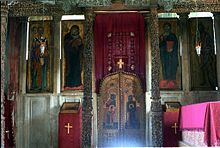Civitella (Carosino)
Civitella is a former settlement in the southern Italian province of Apulia 3000 steps (about two kilometers) south of Grottaglie . Today only the Masseria Civitella , which belongs to Carosino in the province of Taranto , remains .
history
Civitella was a "casale" and belonged to the Astorre family. When the daughter Augusta married Giacomo Carignano (also: Caragnano), she brought the Casale into the marriage as a dowry. At that time Civitella numbered around 100 people who paid their dues to their feudal lord Carignano.
At a time of recurrent epidemics and wars that brought the fiefdoms always in danger, the son Girolamo populated Casale in 1540 with about 200 exempt Albanians ( Arbëresh ) and made for them a chapel built in order to its Greco-Byzantine rite could exercise . In 1553 more tax-exempt Albanians were added when the Albanian Giorgio Mastolano received permission from Emperor Charles V to live with other compatriots in the Casale.
When Civitella received his first pastoral visit from the Archbishop of Taranto, Lelio Brancaccio , in 1578 , a third of the population (10 families) belonged to the Latin rite . They had their own priest and their own church. The Arbëresh, who made up two thirds of the population (20 families), had their own church with a single-door iconostasis . The chaplain was Giovanni Turco de Abbate Matteo, who administered all the sacraments apart from baptism . It was baptized by a dad from the neighboring parishes.
Although Pope Paul III. gave the Albanians in Italy full recognition within Catholicism with the bull of 1536 , Brancaccio encouraged the Greek Orthodox community of Civitella to adopt the Latin rite . As in the other Casali of the Albania Tarantina , the Arbëresh of Civitella did not listen to Archbishop Brancaccio's invitation to convert to the Latin rite. ( See also: Section Religion of the Arbëresh )
At the beginning of the 17th century, the Casale belonged to Baron Francesco Antonio Pappadà, who, with the consent of his brother Pietro, ceded it to Prince Fabio Albertini of Faggiano for 22 ducats and 2 tari . In June 1615, Pappadà received royal approval for this sale.
Later Civitella went to the “Mensa Vescovile” (all the goods available for the diocese ) of Taranto, whose prelates owned it as a barony .
Apparently the Casale is said to have been abandoned at the end of the 17th century due to Ottoman raids .
literature
- F. Antonio Primaldo Coco: Casali Albanesi nel Tarentino . Grottaferrata 1921 (Italian, dimarcomezzojuso.it [PDF; accessed on March 13, 2017]).
Web links
- Masserie e feudi nel Tarantino centro orientale (secc. XIII-XVII). (PDF) Perieghesis.it, accessed on May 28, 2017 (Italian).
Remarks
- ↑ Masseria: several rural buildings for agricultural operations, typical in southern Italy
- ↑ Casale (plural casali ) is the Italian name for a house or a group of houses in the country.
- ↑ Secular clergyman in the Orthodox Church
Individual evidence
- ^ Masseria Civitella. Masseriacivitella.com, accessed May 21, 2017 (Italian).
- ^ A b c d e Nicola Maiellaro: Albania: Conoscere, Comunicare, Condividere . Associazione Nazionale Comuni Italiani (ANCI) Apulia, 2004, p. 179 (Italian, cnr.it [PDF]).
- ↑ a b c d e Casali Albanesi nel Tarentino, p. 49.
- ^ Giuseppe Maria Viscardi: Tra Europa e "Indie di quaggiù". Chiesa, religosità e cultura popolare nel Mezzogiorno . Storia e Letteratura, Rome 2005, ISBN 88-8498-155-7 , p. 377 (Italian, online version in Google Book Search).
Coordinates: 40 ° 28 ′ 49.7 ″ N , 17 ° 24 ′ 52 ″ E

